Heavy multimode strategic bomber with variable sweep wing. Created in OKB MMZ "Experience" Tupolev, chief designer from 1975 to 2010, Valentin Bliznyuk. The aircraft in general is similar to the multi-project bomber M-18 OKB V. Myasishev. The original version of the Tu-160 had a wing ogival shape and design based on the Tu-144 (1969-1972 GG). Preliminary research and development on the Tu-160 with a variable geometry wing began in 1972. Design of the final version - articles 70, Tu-160M project, the plane "K" started in 1975 by order of the USSR on June 26, 1974 and Resolution CM USSR N 1040-348 of 19/12/1975, the draft design of a full-size layout and the creation of the Tu-160 - 1976-1977 GG
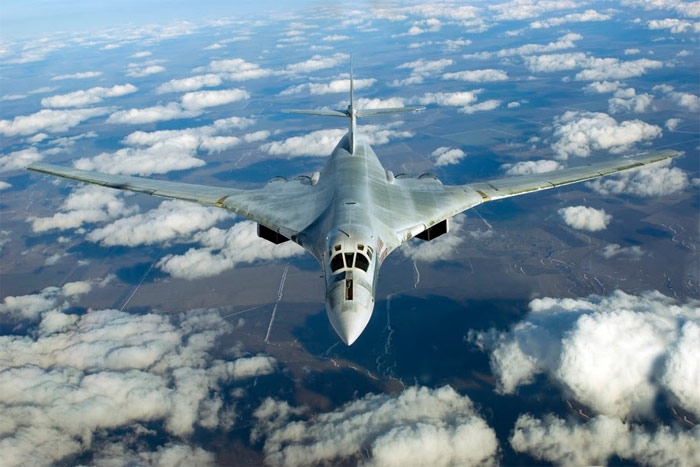
Tu-160 - BLACKJACK, boom refueling released, 21.03.2008 (Photo Sergei Brovko, http://picasaweb.google.com/brovko.sergey ).

Tu-160 - BLACKJACK, boom refueling released, 21.03.2008 (Photo Sergei Brovko, http://picasaweb.google.com/brovko.sergey ).

Tu-160, "Alexander Novikov," board №12 Identification No RF-94109 is probably Engels, 2013 (photo - Vadim,http://russianplanes.net/id107472 ).

The second prototype of the Tu-160 (70-03) for the air show MAKS-1995, Zhukovsky, 08/27/1995 (photo Paul nann,http://www.paulnann.com )
The layout of the Tu-160 was approved in late 1977 Production of the first three prototypes (70-01 cars for flight tests, 70-02 for static tests, 70-03 - pre-production aircraft) started in 1977, MMZ "Experience" (production of the fuselage - Kazan aircraft plant, wing and stabilizer - Novosibirsk Aircraft Plant im.V.Chkalova sash gruzootseke - Voronezh aircraft factory, the chassis - the Gorky aircraft plant).At the same time started the preparation of series production at the Kazan aircraft factory №22 (initially deploy planiroalos proizodstvo at Ulyanovsk aviazovode). In May 1980, a prototype was built 70-01 and moved to LII airfield in Zhukovsky. Final assembly of the aircraft completed in January 1981 and started ground testing aircraft. Roll-out of the plane onto the tarmac 70-01 - August 18, 1981 Check systems and equipment commenced October 22, 1981 and November 14, 1981 under the control of the crew B.I.Veremeya plane made the first run. The first photo in the West made on board a commercial aircraft taking off from the airport Bykovo
November 25, 1981 - the plane was named RAM-P ("Ramenskoye" unidentified sample techniques №16). The first flight of the prototype (article 70-01) - 18 December 1981 of (crew B.I.Veremeya, copilot S.T.Agapov, navigators - M.M.Kozel, A.V.Eremenko). Started production of the two experimental series (8 aircraft) at the Kazan aircraft plant. Home Test - 1983 First flight of the Tu-160 pre-series (70-03) - October 6, 1984 (crew S.T.Agapova). The first flight of the first production of the Tu-160 (V.V.Pavlova crew, the plane 01-01 of the first test series) - 10.10.1984, at the second (№01-02) - 16.03.1985, at the third (№02- 01) - 25.12.1985, at the fourth (№02-02) - 15.08.1986, the Tu-160 (№70-01) first reached the speed of sound in the test in February 1985. In the tests lost one aircraft ( №01-02, spring 1987, the crew ejected).
The first two Tu-160 experimental series came in the 184th Guards YES Priluki Ukraine on April 17, 1987 before the completion of state tests. Large-scale production of the Tu-160C (name of the series) in the factory in Kazan Gorbunova - May 1987 state tests Tu-160 conducted in 1989 (completed in the middle of the year, made 4 missile launches X 55). Data on formal acceptance of the Tu-160 into service before 1991 do not. The aircraft set 44 world records (see. Site FAI ). By default, the serial Tu-160. The message on the website of the Ministry of Defense of Russia on 07.02.2012, states that one Tu-160 passes alterations in the modification of the Tu-160M on one of the Russian military-industrial complex (probably at the Kazan aircraft plant ).

Model multimode bomber M-18 OKB Myasishcheva project, 1970-1972 GG
(Gordon E., Tu-160. M., Polygon Press, 2003)


General view of the projections of the Tu-160 of the draft design and a model created in the development of conceptual design, 1975 (E. Gordon, the Tu-160. M., Polygon Press, 2003)

The first image of the Tu-160 known in the West - the same "satellite" snapshot of the Tu-160 (made with wilted civil aircraft taking off from the airport Bykovo November 25, 1981, DoD USA)
The design of the airplane - integrated circuits glider, the differential all-moving stabilizer and all-moving upper part of the keel. Two compartment placing payloads are tandem (one behind the other). Basic materials glider - Ti - alloys from 4 (the central supporting beam fuselage 12.4 m length and 2.1 m wide, up to 20% by weight of the airframe), heat-treated aluminum alloys, B-95-T2, AC-4 and HT-6, steel alloys and composite materials (ok.3% by weight of the structure).
The hydraulic systems of the aircraft used by major oil SP-50, the system 4-channel with a working pressure of 280 kg / cm. The aircraft is equipped with a toilet, a kitchen, bed. Radar absorbing coating is applied to the inputs of air intakes dvigeteley (graphite) and the nose of the aircraft (special paint on an organic basis), glazing made with mesh filters, screened motor. The aircraft is equipped with a receiver refueling system of "hose-cone." The mass production of airframe components manufactured - the wings and engine compartment - Voronezh aircraft factory, feathers and air intakes - Irkutsk aircraft factory, the chassis - Kuibyshev Assembly Plant, the fuselage. center section and units of turning wing consoles - Kazan aircraft plant.
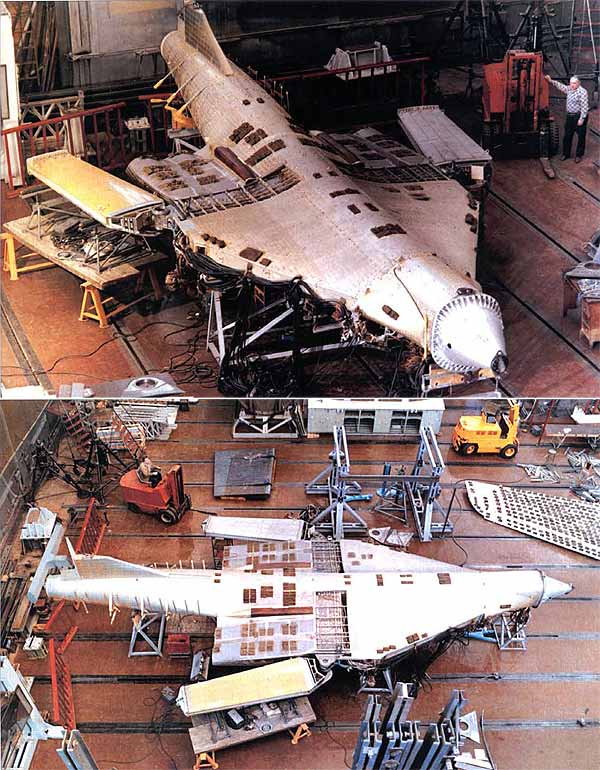
Assembling the model and strength analogue Tu-160 on a scale of 1: 3 to MMZ "Experience", 1976-1977 GG (Gordon E., Tu-160. M., Polygon Press, 2003)

Cabin crew inside during the construction of the first instance of the Tu-160 - the plane 70-01, 1977
(Gordon E., Tu-160. M., Polygon Press, 2003)



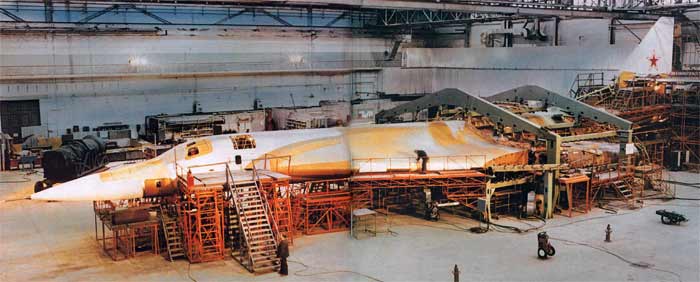

Assembling the fuselage of the first copy of the Tu-160 - the plane 70-01 in the shop MMZ "Experience"
(Gordon E., Tu-160. M., Polygon Press, 2003) Air intakes and main landing gear of the Tu-160 "Valery Chkalov" on Engels airbase, beginning in November 2012 (photo - RostovSpotter, source ).


Control of the aircraft is carried out analog FBWCS with 4x redundant channels of pitch, roll and yaw, as well as to the implementation of the principle of e-sustainability. The modernization of the type of mod.2006 is likely install digital FBWCS.
- Preliminary design of the Tu-160 - 4 x turbofans NK-25 OKB CMH "Trud" chief designer ND Kuznetsov (Kuibyshev)
- Tu-160 - 4 x three-shaft turbofans NK-32 (a product "P") EDO CMH "Trud" chief designer ND Kuznetsov (Kuibyshev - later - Samara).Home R & D engine - 1970 tests since 1977 on the Tu-95 Series - 1986 engine thrust of 14,000 kg, afterburner - 25000 kg. Engines equipped with adjustable air intake (at B-1B - it's not), reduced radar and infrared signature of the engine and fuel consumption. The engine management system with the hydro electric duplication (in the modernization process can be replaced by a digital control system). In 1986, experimental and serial Tu-160 installed engines experienced a series of recent tests CMH "Trud".
Engine length - 6000 mm
diameter (for air inlet) - 1460 mm
diameter turbine - 1000 mm
Weight of dry - 3,400 kg
diameter (for air inlet) - 1460 mm
diameter turbine - 1000 mm
Weight of dry - 3,400 kg
Weight of compressor engine - 365 kg
Stagnation temperature gas turbine - 1375 degrees C
Stagnation temperature gas turbine - 1375 degrees C
Specific fuel consumption of the engine (speed <1M) - 0.72-0.73 kg / kg per hour
Specific fuel consumption of the engine (speed> 1M) - 1.7 kg / kg per hour
Engine life - 250 hours (the first prototypes and series) - increased to 750 hours by 1991.
The total service life as of 2007 - 3000 hours to 1000 hours lifespan overhaul
The total service life as of 2007 - 3000 hours to 1000 hours lifespan overhaul
In the niche of the left main landing gear strut placed gas turbine auxiliary power unit TA-12 provides power to the aircraft.
- A modernized Tu-160 (2006) - 4 x upgraded turbofan NC-32 - NC-321 engine upgrade started in 2004 Samara OAO "SNTK im.Kuznetsova." The first new engines are ready in April 2006, significantly increased engine life and improved reliability. By mid-2006 engines we have gone through all kinds of tests, including Flight government. In December 1995, prepared by the plane T-144LL (№77114) of which was held in April 1999 a joint Russian-American research program. On the plane were installed 4 NK-321. The first series of flights (19 flights) completed in February 1998. The second series of flights to the achievement of speed of 2 m was conducted from September 1998 to April 1999
Power is provided by an auxiliary power unit TA-12 and 4 x drive-integrated alternator., as well as battery (emergency power supply).
TTH aircraft :
Crew - 4 people. (Two pilots, a navigator and an operator located in two cabins).
Length - 54.095 m
Wingspan:
- Take-off / landing - 55.7 m (on the conceptual design)
- Take-off / landing - 57.7 m (in the series)
- at cruising - 50.7 m
- maximum speed - 35.6 m
span stabilizer:
- at cruising - 50.7 m
- maximum speed - 35.6 m
span stabilizer:
- 13.75 m (prototype "70-01" and the first pre-series)
- 13.25 m
Height - 13.1 (13.2) m
Wing area:
Height - 13.1 (13.2) m
Wing area:
- 293.15 m (base)
- 400 m (with a minimum sweep)
- 370 m (at maksimlanoy sweep)
The area of the rotary wing - 189.83 sq.m.
Area flapperonov - 9 sq.m.
Area flaps - 39.6 m
Area slats - 22.16 sq.m.
Area spoilers - 11.76 m
keel area - 42.025 sq.m.
keel area - 42.025 sq.m.
The area of the turning part of the keel - 19.398 sq.m.
Wing sweep - 20-35-65 degrees. in different modes
Sweep stabilizer - 44 degrees. (Leading edge)
Sweep keel - 47 degrees. (Leading edge)
track chassis - 5.4 m
Base Chassis - 17.88 m
Dimensions main wheels - 1260 x 485 mm (2 to 6 bogie wheels)
Dimensions nose wheel - 1080 x 400 mm (1 truck, 2 wheel)
Dimensions weapons compartment - 2 compartment clearance 11.28 x 1.92 x 1.9 m
length of the motor gondola (without wedge) - 13.78 m
track chassis - 5.4 m
Base Chassis - 17.88 m
Dimensions main wheels - 1260 x 485 mm (2 to 6 bogie wheels)
Dimensions nose wheel - 1080 x 400 mm (1 truck, 2 wheel)
Dimensions weapons compartment - 2 compartment clearance 11.28 x 1.92 x 1.9 m
length of the motor gondola (without wedge) - 13.78 m
Take-off weight:
- 260 000 kg (according to the preliminary design 1976)
- 275 000 kg (according to some sources - up to 280000-285000 kg)
Take-off weight is normal - 267 600 kg
Take-off weight for the aerodrome 1 class - 185000 kg
Landing Weight - 140000-155000 kg
Empty weight:
Landing Weight - 140000-155000 kg
Empty weight:
- 103 000 kg (according to the preliminary design 1976)
- 110,000 kg of
thrust-weight ratio - 0.36 (B-1 B - 0.25)
thrust-weight ratio - 0.36 (B-1 B - 0.25)
The mass of the fuel:
- 148 000 kg (according to the preliminary design 1976)
- 140 600 kg (148,000 kg - for dr.dannym)
- 171000 kg (the maximum according to Gordon)
Payload weight:
Payload weight:
- The rate (at maximum range of the project) - 9000 kg
- The norm - 16330 kg
- the maximum actual - 22400-22500 kg
- the maximum allowable - 40,000 kg (on the project and actually according to some)
- the maximum actual - 22400-22500 kg
- the maximum allowable - 40,000 kg (on the project and actually according to some)
- The maximum allowable - 45,000 kg (according dr.dannym, B-1B - 34000 kg)
Maximum speed at the height (of the project) - 2300-2500 km / h (B-1B - 1328 km / h)
Maximum speed at low altitude (on the project) - 1,000 km / h (B-1B - 1160 km / h)
Maximum speed at an altitude of 13,000 meters in afterburner engine operation at an angle of 65 degrees of sweep. - 2200 km / h (2 M)
Maximum speed eksluatatsionnaya - 2000 km / h (the limit for combat units in order to preserve the resource glider)
cruising speed maximum - 1.5 M
Maximum speed at low altitude - 1030 km / h
Average speed record on a closed route of 1000 km with a mass of 30,000 kg Mo - 1720 km / h
average speed record on a closed route of 2000 km with a takeoff weight of 275,000 kg - 1675 km / h
speed takeoff - 270-370 km / h (at a weight - 150 -275 m)
average speed record on a closed route of 2000 km with a takeoff weight of 275,000 kg - 1675 km / h
speed takeoff - 270-370 km / h (at a weight - 150 -275 m)
The rate of landing:
- 260-280 km / h (at a weight - 140-166 m)
- 260-300 km / h (at a weight - 140-155 m)
Breakthrough defense on speed:
- High altitude (Hi) - 1,9 M
- at low altitude (Lo) with automatic terrain following - 1 M
of climb - 60-70 m / s
- at low altitude (Lo) with automatic terrain following - 1 M
of climb - 60-70 m / s
ceiling practical:
- 18,000-20,000 meters (project)
- 15,000 m (18,000 m according to other sources)
in the ceiling of a record 275,000 kg of weight - 11250 m
in the ceiling of a record 275,000 kg of weight - 11250 m
Flight distance (without refueling)
- Mode Hi-Hi-Hi, speed <1M, weight 9000 kg Mo (on the project) - 14000-16000 km (B-1B - 12,000 km)
- Mode of Hi-Lo-Hi (including 2,000 km at an altitude of 50-200 m) or at a rate of> 1 M (project) - 12000-13000 km
- Mode Hi-Hi-Hi, Mo 22400 kg weight with a maximum take-off weight - 12300 km (B-1B - 10400 km)
- Maximum MON - 10500 km
Radyus actions with one refueling regime for Lo-Lo-Lo or Hi-Lo-Hi - 7300 km
range of the maximum at a cruising speed of 1.5 M - 2000 km
Radyus actions with one refueling regime for Lo-Lo-Lo or Hi-Lo-Hi - 7300 km
range of the maximum at a cruising speed of 1.5 M - 2000 km
Combat radius without refueling weapons systems (including CBRC range X-55) - 9150 km
Takeoff - 900-2200 m (mass of 150-275 tons)
traveled - 1200-1600 m (mass of 140-155 tons)
Takeoff - 900-2200 m (mass of 150-275 tons)
traveled - 1200-1600 m (mass of 140-155 tons)
The maximum time of flight without refueling - 12:00 50 min (1989, the crew of Valery Gorgol - commander of the 184th Gv.TBAP, g.Priluki)
Standard flight time - 12-15 hours
maximum flight duration - 21 hours (2009, 2 refueling) and 23 hours (09-10.06.2010, at 2 refueling)
Maximum operating overload - 2,5 G (2G according to Gordon)
Efforts to prepare for the flight one hour flight - 64 people / hour
Time to prepare the aircraft for the flight - 3 days (1987, further reduced)
The area of the drogue parachute (3 pieces) - 105 sq.m.
The initial draft of the Tu-160 (1975 YG):
1) 2 x H-45, H-45M later
2) 24 x 15 x
3) 10-12 x X-55
4) 10-12 x X-15M
5) conventional bombs, nuclear bombs, UAB laser seeker and TV, sea mines.
At the request of the Air Force involves the installation of a defensive artillery gun with a gun GSH-6-30.
The basic version of the Tu-160 (1981, the project):
1) x 12 AS-15 (X-55 / X-55M) on two revolving ISU-6-5U
2) 24 x AS-16 ( X-15 ) on four revolving ISU (option arms are not brought to realization)
3) 4 x nuclear bomb capacity of 5, 20 (?), 50 (?) Matthew
4) 16 x FAB-1000
5) 22 x 750 FAB-
6) CC-1500
2) 24 x AS-16 ( X-15 ) on four revolving ISU (option arms are not brought to realization)
3) 4 x nuclear bomb capacity of 5, 20 (?), 50 (?) Matthew
4) 16 x FAB-1000
5) 22 x 750 FAB-
6) CC-1500
Really made Tu-160 (1987-2009 years):
1) x 12 AS-15 (X-55 / X-55SM) at two ISU-6-5U - basic version of armaments, state tests of the system - 1989 (basic version - X-55SM, adopted by the Air Force 1986) . By 2005, the portion of aircraft converted for use Kh-555 (for example, the Tu-160 "Pavel Taran" is probably just "Alexander Golovanov" and "Alexander Molodchy").
2) 12 x AS-16 ( X-15 ) in two ISU-6-5U (not in actual combat units)
In the process of modernization along the lines mod.2006, in the range of weapons to be included CBRC X-555, X-101 and X-102, aeroballistic rockets AS-16 ( X-15 ), svobodnopadayuschie conventional bombs and UAB.
Aircraft weapons systems and patterns of use of weapons designed in conjunction with GosNIIAS. From Tupolev supervised the creation of complex weapons L.N.Bazenkov. The main means of destruction (CBRC) developed MKB "Raduga" A.Ya.Bereznyaka (chief designer Seleznev IS).
Equipment :
The main developer of avionics - NII "Elektroavtomatika" (Leningrad, chief designer - E.S.Lipin).
The main developer of avionics - NII "Elektroavtomatika" (Leningrad, chief designer - E.S.Lipin).
Sighting and navigation system Tu-160 includes a dual-channel astroinertial navigation system K-042K, astrovizir 1cm AV development and production of CDB "Arsenal" (Kiev), automatic terrain following system, satellite navigation system GLONASS (accurate to 10 20 m, the modified production system MKB "Kompas" since 2007 will be installed in all airplanes when upgrading) and multi-channel digital communication system. Total aircraft systems involved more than 100 onboard computer, including the navigator onboard computer 8 and the plate-kursoprokladchik PA-3 (with a moving map, probably digital?). Cockpit equipped with a standard set of equipment with traditional displays and dials the type Tu-22M3 . Instead, use the wheel control handle (joystick) similar to the fighter.
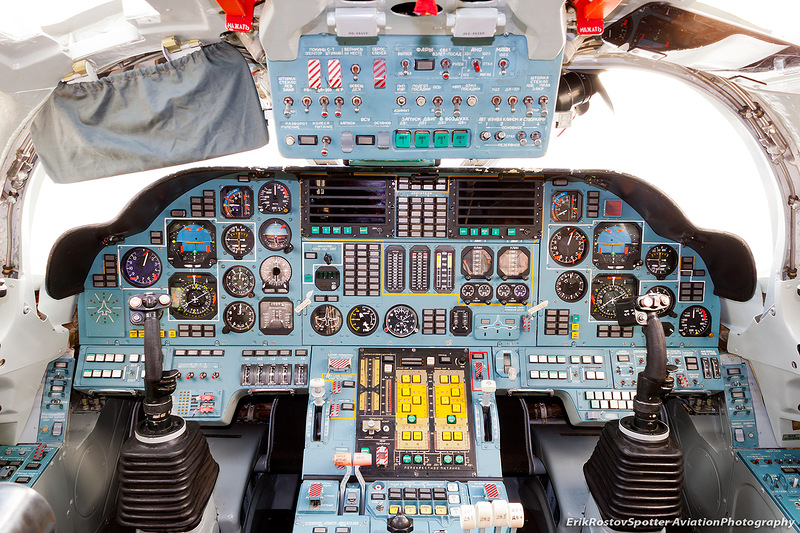
The cockpit of the Tu-160 "Valery Chkalov" on Engels airbase, the beginning of November 2012 (photo - RostovSpotter, source ).
Astrovizir AV 1cm - measures the angular coordinates of the stars to the 4th magnitude in the daylight sky background with an error of less than 0.01 degrees.
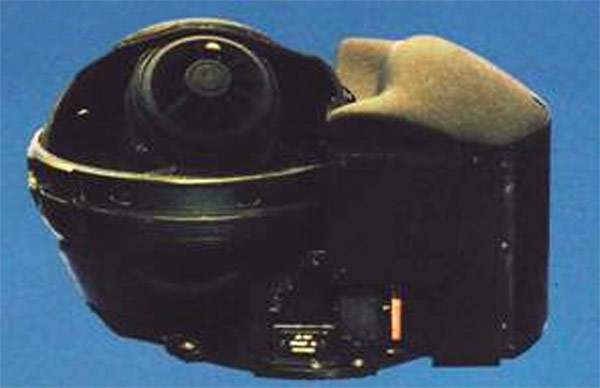
Astrovizir AV 1cm (Buzanov VI Enterprise "CKB" Arsenal "- the improvement and creation of new opto-electronic aircraft equipment. // Aviation and time. Special edition, 2003).
Sighting and navigation complex "Obzor-K" Including a bombing and navigation radar "Search" (the detection range of the major objectives of radio-purposes with the high altitude - 600 km or more), and electro-optical bombsight OPB-15T "Thunderstorm" (daytime bombing or the bombing in low light, T - probably "TV"). The modernization of the aircraft can get laser pointer for use air bombs with laser seeker to greater heights. The control system missiles "Octopus-SM" (introduction to the GOS targeting missiles before launch, enforcing CBRC).
The radar visibility of the aircraft dropped additional measures for applying to the nose of a special paint on an organic basis, radar absorbing black graphite film on the air inlets and air ducts, shielding certain engine components, and an introduction to the cabin windows antiradar mesh filters. Some of these activities performed in line units.
On-board defense system (GER) "Baikal" detects and classifies any enemy radar, thermal target (teplopelengator "Spark" is located at the rear of the fuselage point) and provides for the use of active electronic warfare, submarines and passive IR-traps (EW equipment located in the tail cone ). Refinements GER completed in April 1990
The system of in-flight refueling. Ejection seat K-36DM development NGOs "Star" (chief designer G.I.Severin) with backs equipped with pulsating air cushions (in series production). Individual system bailout and forced the entire crew (starting from any workstation). Bailout is possible in the "0-0" (zero speed, zero altitude) - after improvements in the process of development (originally - the minimum speed of the bailout - 75 km / h). When the flight crew altitude profiles using high-altitude suits-suits "Cormorant" (there are only prototypes - according to Butovo, 1995). In standard mode - helmet ZS-7B or ZS-7AS.

High-altitude suit, spacesuit "Cormorant" (Gordon E., Tu-160. M., Polygon Press, 2003)
The upgraded complex avionics created jointly by JSC "Tupolev", Federal State Unitary Enterprise "State Research Institute of the AU", Federal State Unitary Enterprise "Design Bureau" Elektroavtomatika "them. Efimova" and GLITS them. Chkalov. 26.03.2013, in the media reported on the completion of ground tests oboroudovaniya complex. As a result of complex HIL test stand specialists received the opinion of airworthiness flight tests. They are expected to be held in 2013. Work on updating bortoborudovaniya conducted in the first phase of modernization of the Tu-160.
Modifications:
Tu-160 (1969-1972 years) - the first project of the contest 1972 - based bomber Tu-144.
Tu-160M preliminary design (1972) - Study options for the design of aircraft with variable geometry wing.
Tu-160M (1975) - the second draft of the Tu-160 igmenyaemoy-wing (the name on the stage of preliminary study of the project).
Tu-160 (product 70) BLACKJACK / RAM-P (first flight - 1981) - IG wing bomber pilot series.



The first copy of the Tu-160 - the aircraft on the basis of 70-01 FRI in Zhukovsky in the beginning of the test
(Gordon E., Tu-160. M., Polygon Press, 2003)
Tu-160 - a carrier UAV "Raven" (a project mid-1970s) - the initial stage of the project Tu-160 airplane planned to use as a carrier of strategic supersonic unmanned reconnaissance aircraft "The Raven" (Tupolev) with a starting weight 6300 kg. Design discontinued in the mid-1970s due to the closure of the program creating a UAV.
Tu-160P (project mid-1970s) - heavy fighter escort armed with missiles "air-air" large and medium-range missiles. The project is not implemented.
Tu-160C BLACKJACK (1987) - the production version of the bomber.
Tu-160PP (project mid-1980s) - jammer aircraft, according to the design requirements of the Air Force assumed at the stage of creating the project Tu-160. The full design began in the mid-1980s, built a full-size layout. The project is not implemented.
TU-160 modernization (draft, 1980) - in the process of elaboration of the modernization of the Tu-160 was assumed to shift to more fuel-efficient engines NK-74, replacement of equipment and retrofitting more modern weapons. Probably this upgrading was planned until 1996 (our assumption).
Tu-160B (draft, 1980) - a variant of the Tu-160 engines on liquid hydrogen with a modified design of the fuselage. The project is not implemented.
Tu-160K "Merlin" (project 1983-1984) - Project equipment Tu-160 aircraft with two ballistic missile launch "Merlin" ("Southern") weighing 24.4 tons.
Combat radius of the complex - 10,000 km
Tu-160M (draft, 1990) - the project Tu-160 with modified compartments Mon - medium KR 2 hypersonic X-90. The existence of the project has not been confirmed.
Tu-160SK (draft, 1992) - the aircraft carrier rocket "Burlak" and "Burlak-Diana" to launch a satellite into orbit.
Tu-161 (draft, 1990) - the project of modernization and development of the Tu-160 as a multi-mode aircraft carrier CBRC.
PAK DA (draft, 1999) - PAK DA, the design appearance of aircraft in a variety of CB started in 1999. The Tupolev plane PAK DA is designed on the basis of the Tu-160 (according to media reports).
TU-160 modernization / Tu-160M (2006-2007) - a modernized version of the Tu-160 series (the name "Tu-160M" is used in some online media) - originally planned to modernize fleet of Tu-160 to 1996 ., but actually the modernization started after 2000 changed the composition of avionics, upgraded engines NK-32 / SC-321 (to increase the resources, increased reliability tests completed in 2006), aircraft can carry missiles X-555 and X 101/102. In addition, the upgraded version can high-precision (accuracy - 20 m) use conventional bombs and svobodnopadayuschie UAB (formerly apparently only declaratively). As part of the new avionics are installed on-board computer, satellite navigation system development MKB "Kompas", increased range and endurance, upgraded airborne defense. The first plane is the plane passed the modernization of serial №02-02 "Valentin Bliznyuk" (after modernization entered the Air Force July 5, 2006).The modernization program is declared to the planned completion in 2015 (data from December 2009), all declared the modernization of 15 aircraft. In a statement on the website of the Ministry of Defense of Russia on 07.02.2012, it states that one Tu-160 passes alterations in the modification of the Tu-160M on one of the Russian military-industrial complex (probably at the Kazan aircraft plant). 26.03.2013 was informed of the completion of ground tests of the modernized complex avionics for the aircraft. For 2013 it is scheduled to begin flight testing complex.
The cost of the aircraft were as follows:
Before 1990 - 48 million. rubles
in 1991 - more than 70 mln. rubles
in 1992 - more than 300 mln. rubles
Before 1990 - 48 million. rubles
in 1991 - more than 70 mln. rubles
in 1992 - more than 300 mln. rubles

No comments:
Post a Comment